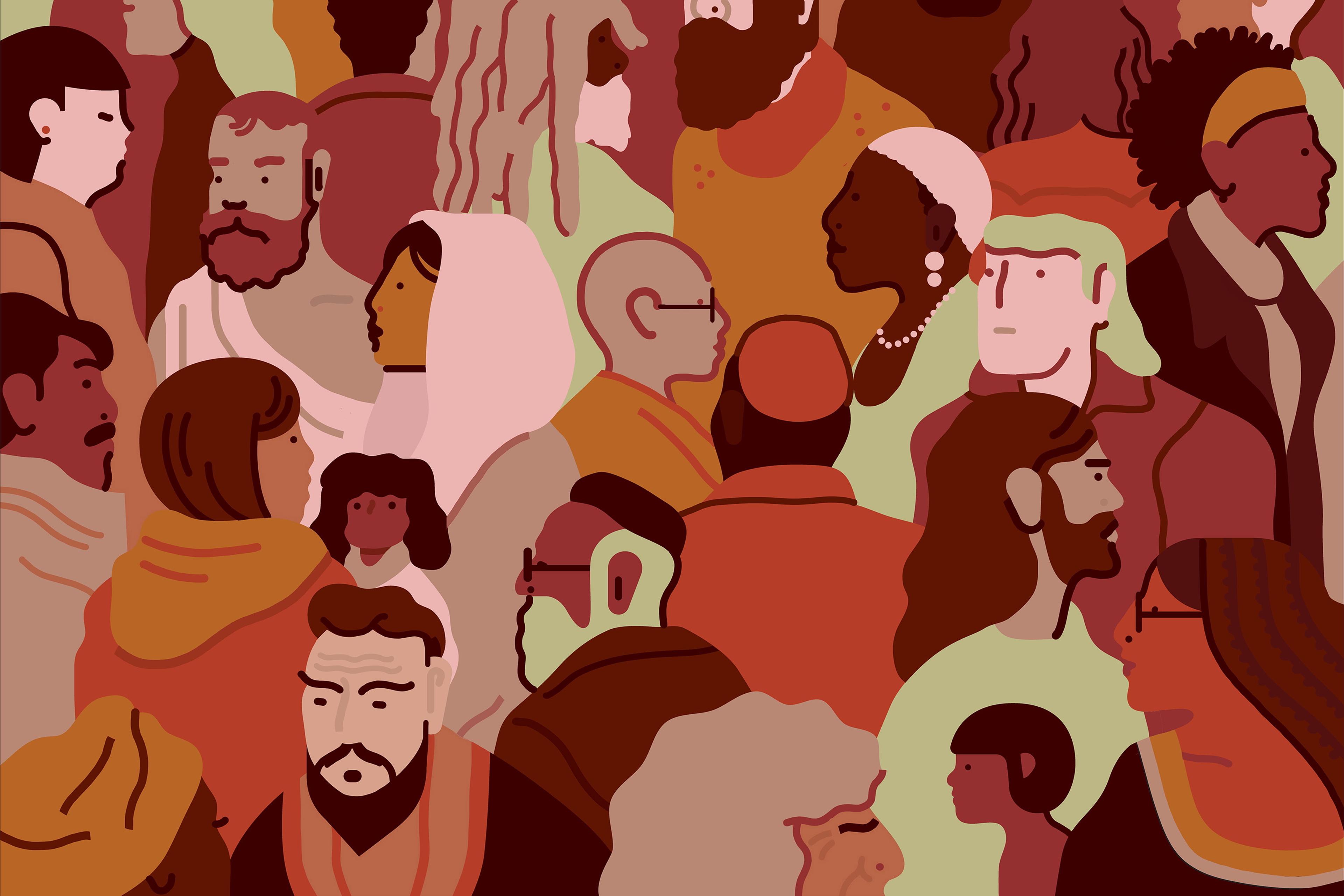The idea that people in the ‘East’ and in the ‘West’ differ psychologically in important ways has been studied for decades and popularised in countless articles and books. You might have read that, compared with East Asians, people in North America tend to place more value on being unique, for example, or that they are more inclined to focus on their own positive qualities. Indeed, various aspects of ‘self-construal’ – that is, how people see themselves in relation to others – have been reported to vary in this way, with some cultures, notably in East Asia, showing a more interdependent emphasis (on how people are related), and others, such as those in the US and Canada, having a more independent emphasis (focused on being distinct and independent).
This work has helped to demonstrate that psychologists can’t assume that a finding in one part of the world will necessarily hold up in another. Such differences are also suggested to have various important consequences for how people in different cultures behave individually, such as whether they are prepared to speak out, and collectively, such as in the way a community responds to disaster.
But cultural psychologists have warned that relying too much on a binary, East-versus-West view risks oversimplifying the reality of cross-cultural psychological differences. The originators of self-construal theory, Hazel Markus and Shinobu Kitayama, have themselves highlighted the importance of other kinds of cross-cultural comparison, and they acknowledged in the early 1990s that there is large variation within each culture, and overlap across cultures, in terms of how people define themselves. Tantalisingly, there is also a great deal of underexplored psychological ground outside of the East-West framework.
With a recent crop of papers, researchers have aimed to capture more of this complexity. And their findings give plenty of reasons to think that many cultures don’t fit into neat patterns of either interdependent or independent thinking.
For instance, for their large study published earlier this year, an international team led by Ayse Uskul, now at the University of Sussex in England, compared not only participants in the US, the UK, Japan and Korea, but also people in societies ringing the Mediterranean Sea: Egypt, Greece, the Greek Cypriot and Turkish Cypriot communities, Italy, Lebanon, Turkey and Spain. The team used a variety of measures designed to test for evidence of independent or interdependent orientations.
Their findings challenge the usual interdependent vs independent binary. As Uskul and her colleagues put it, participants from the Mediterranean societies ‘distinctively emphasised several forms of independence … and interdependence’. For example, in response to some questions about how they viewed themselves in relation to others, the Mediterranean participants gave more independent responses, on average, than either East Asians or Anglo-Westerners – such as by indicating that they liked being different from (as opposed to similar to) other people; that they tended to rely on themselves (rather than on others); and that they favoured self-expression over preserving harmony in relationships.
Yet on other points, the Mediterranean-based participants gave relatively interdependent answers – for example, on questions about connection to others (eg, ‘If someone in your family achieves something, you feel proud, as if you had achieved something yourself’).
Considering what might help explain this mixed pattern of results, the researchers drew on previous theorising about the role of honour in Mediterranean cultures. In this view, honour is treated within these cultures as a valued resource that reflects ‘both a person’s own self-worth as well as the worth assigned to the person by others in the society’. This might contribute to some independent ways of being as well as some interdependent ones, they suggested.
The researchers aren’t out to propose a sweeping ‘Mediterranean identity’, Uskul tells me. There was significant variation in results among the different participant groups from the region. But Uskul notes that, on the measures she used, the Mediterranean samples were more similar to each other than they were to the ‘Western’ or ‘Eastern’ samples. They didn’t fit neatly on either side of the binary.
Also complicating an East-West perspective is a 2022 paper co-authored by Kuba Krys at the Polish Academy of Sciences and his colleagues. The team analysed their own and others’ previously collected data to explore how people from Latin American countries – such as Brazil, Chile and Colombia – answered questions, compared with people from East Asian and Western countries.
‘Again we have this pattern, where people in Latin American societies seem to endorse some kinds of independence and some kinds of interdependence,’ says Vivian Vignoles at the University of Sussex in England, who was a co-author both on this paper and on the Mediterranean paper. Whereas Latin American participants tended to rate as relatively independent on a number of dimensions, including an orientation toward self-reliance and toward being different from others, they also tended to score high on, for example, receptiveness to other people’s influence (considered a dimension of interdependence).
There were ‘differences of nuance’ with the Western samples, but ‘it’s very clear that Latin American societies do not have similar models of the self to East Asian societies,’ says Vignoles. ‘And that obviously goes against the traditional West-versus-the-rest binary.’ In their paper, the researchers considered various cultural features – such as modes of subsistence, religious and philosophical traditions, colonial history, and more – that they think could potentially help account for tendencies toward certain forms of independence or interdependence.
The analysis by Vignoles and his colleagues also challenges the seemingly commonsense assumption that cultures that are deemed ‘collectivistic’ (prioritising the group over the individual) – such as in Latin America, Asia and elsewhere – will promote interdependent self-construal, rather than independent self-construal. The Latin American participants showed their mix of independence and interdependence, despite living in cultures that are usually characterised as collectivistic.
The mingling of ‘independent’ and ‘interdependent’ ways in these studies raises a question: does it make sense to think about them as two distinct concepts? ‘The way I see them, they are useful umbrella terms [for exploring cross-cultural differences],’ Vignoles says. But neither should be considered a monolithic feature of cultures, he suggests. ‘As soon as you think that independence is “a thing”, or interdependence is “a thing”, then you’re edging along the wrong route.’ Each is an abstract collection of variables that, as the research shows, don’t always go together.
Igor Grossmann, a psychologist at the University of Waterloo in Canada, who conducts research in cultural psychology but wasn’t involved in either of these new studies, has some reservations about what can be gleaned from the research on constructs such as independence and interdependence. One is a concern about the measurements that researchers have tended to use, including self-report questionnaires: ‘There is always a layer of bias – ie, how people would like to present themselves in this vs that environment may distort the results,’ he says. He also suggests that ‘stories about why cultural differences between different regions in the Americas, Middle East or elsewhere emerge are just that – stories.’ Most scholars, he says, lack the data to support claims about putative factors such as subsistence modes or religious groups.
Nevertheless, Grossmann agrees that it makes sense to go beyond ‘weird dichotomies’ such as the East-versus-West binary in cultural psychology. Even a term such as ‘Western’ is often defined in different ways by different people, he notes.
A core takeaway from the recent developments in the field, then, is the need to be wary about dividing the world into simplified cultural categories (even seemingly innocuous ones) and assuming that groups will tend to land on one side or the other of theoretical borderlines. In the ways we view ourselves, as in other domains, humans are varied and complex. ‘There aren’t just two different kinds of people in the world, us and them,’ Vignoles says. ‘We are much more diverse – but, at the same time, much more similar to each other – than is often realised.’








